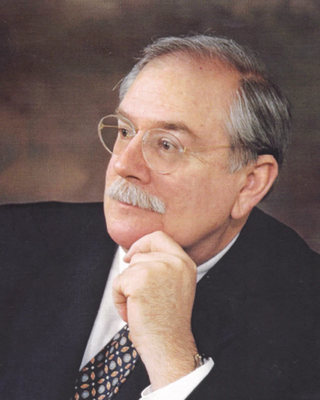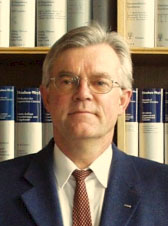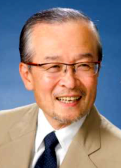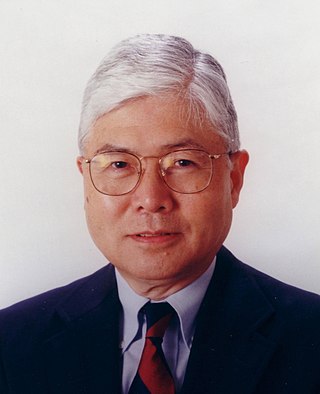
Ryōji Noyori is a Japanese chemist. He won the Nobel Prize in Chemistry in 2001, Noyori shared a half of the prize with William S. Knowles for the study of chirally catalyzed hydrogenations; the second half of the prize went to K. Barry Sharpless for his study in chirally catalyzed oxidation reactions.

Elias James Corey is an American organic chemist. In 1990, he won the Nobel Prize in Chemistry "for his development of the theory and methodology of organic synthesis", specifically retrosynthetic analysis. Regarded by many as one of the greatest living chemists, he has developed numerous synthetic reagents, methodologies and total syntheses and has advanced the science of organic synthesis considerably.
Organic synthesis is a special branch of chemical synthesis and is concerned with the intentional construction of organic compounds. Organic molecules are often more complex than inorganic compounds, and their synthesis has developed into one of the most important branches of organic chemistry. There are several main areas of research within the general area of organic synthesis: total synthesis, semisynthesis, and methodology.

David A. Evans was an American chemist who was the Abbott and James Lawrence professor of chemistry at Harvard University. He was a prominent figure in the field of organic chemistry and his research focused on synthetic chemistry and total synthesis, particularly of large biologically active molecules. Among his best-known works is the development of aldol reaction methodology.
In organic chemistry, umpolung or polarity inversion is the chemical modification of a functional group with the aim of the reversal of polarity of that group. This modification allows secondary reactions of this functional group that would otherwise not be possible. The concept was introduced by D. Seebach and E.J. Corey. Polarity analysis during retrosynthetic analysis tells a chemist when umpolung tactics are required to synthesize a target molecule.

Sir David William Cross MacMillan is a Scottish chemist and the James S. McDonnell Distinguished University Professor of Chemistry at Princeton University, where he was also the chair of the Department of Chemistry from 2010 to 2015. He shared the 2021 Nobel Prize in Chemistry with Benjamin List "for the development of asymmetric organocatalysis". MacMillan used his share of the $1.14 million prize to establish the May and Billy MacMillan Foundation.

Dieter Enders was a German organic chemist who did work developing asymmetric synthesis, in particular using modified prolines as chiral auxiliaries.
The most widely applied of his chiral auxiliaries are the complementary SAMP and RAMP auxiliaries, which allow for asymmetric alpha-alkylation of aldehydes and ketones. In 1974 he obtained his doctorate from the University of Gießen studying under Dieter Seebach and followed this with a postdoc at Harvard University studying with Elias James Corey. He then moved back to Gießen to obtain his Habilitation in 1979, whereupon he became a lecturer, soon obtaining Professorship in 1980 as Professor of Organic Chemistry at Bonn. In 1985 he moved to Aachen, where he was Full Professor of Organic Chemistry and Director. He was editor-in-chief of Synthesis and was on the advisory boards of many other journals including Letters in Organic Chemistry and SynLett.
Henri Boris Kagan is currently an emeritus professor at the Université Paris-Sud in France. He is widely recognized as a pioneer in the field of asymmetric catalysis. His discoveries have had far-reaching impacts on the pharmaceutical industry.
The Ryoji Noyori Prize was established by the Society of Synthetic Organic Chemistry, Japan in 2002 to commemorate Ryōji Noyori winning the 101st Nobel Prize in Chemistry as well as the 60th anniversary of the Society of Synthetic Organic Chemistry. The prize is given "to recognize and encourage outstanding contributions to research in asymmetric synthetic chemistry defined in its broadest sense." The prize is sponsored by Takasago International Corporation.
Eric N. Jacobsen is the Sheldon Emery Professor of Chemistry and former chair of the department of chemistry and chemical biology at Harvard University. He is a prominent figure in the field of organic chemistry and is best known for the development of the Jacobsen epoxidation and other work in selective catalysis.
The Arthur C. Cope Award is a prize awarded for achievement in the field of organic chemistry research. It is sponsored by the Arthur C. Cope Fund, and has been awarded annually since 1973 by the American Chemical Society. It consists of $25,000, a medallion, and $150,000 in funding for research in organic chemistry.

Larry E. Overman is Distinguished Professor of Chemistry at the University of California, Irvine. He was born in Chicago in 1943. Overman obtained a B.A. degree from Earlham College in 1965, and he completed his Ph.D. in chemistry from the University of Wisconsin–Madison in 1969, under Howard Whitlock Jr. Professor Overman is a member of the United States National Academy of Sciences and the American Academy of Arts and Sciences. He was the recipient of the Arthur C. Cope Award in 2003, and he was awarded the Tetrahedron Prize for Creativity in Organic Chemistry for 2008.

Hisashi Yamamoto is a prominent organic chemist and currently a member of the faculty at the University of Chicago and professor of Chubu University.

Yoshito Kishi was a Japanese chemist who was the Morris Loeb Professor of Chemistry at Harvard University. He was known for his contributions to the sciences of organic synthesis and total synthesis.
In organic chemistry, the Fráter–Seebach alkylation is a diastereoselective alkylation of chiral beta-hydroxy esters using strong bases. The reaction was first published by Georg Fráter in 1979; in 1980, Dieter Seebach reported about a similar reaction with malic acid ester.
The Corey–Seebach reaction, or Seebach Umpolung is a name reaction of organic chemistry that allows for acylation by converting aldehydes into lithiated 1,3-dithianes. The lithiated 1,3-dithianes serves as an acyl anion equivalent, undergoing alkylation with electrophiles. The reaction is of pedagogical value, but it is cumbersome, so it is not widely used.
The Tetrahedron Prize for Creativity in Organic Chemistry or Bioorganic and Medicinal Chemistry is awarded annually by Elsevier, the publisher of Tetrahedron Publications. It was established in 1980 and named in honour of the founding co-chairmen of these publications, Professor Sir Robert Robinson and Professor Robert Burns Woodward. The prize consists of a gold medal, a certificate, and a monetary award of US $15,000.
Srinivasan Chandrasekaran is an Indian organic and organometallic chemist, academic and a former chair of the Department of Organic Chemistry and the Division of Chemical Sciences and a former Dean of the Faculty of Science at Indian Institute of Science. He was known for his researches on organic reaction mechanisms and organic synthesis. and was an elected fellow of the Indian National Science Academy, The World Academy of Sciences and the Indian Academy of Sciences. The Council of Scientific and Industrial Research, the apex agency of the Government of India for scientific research, awarded him the Shanti Swarup Bhatnagar Prize for Science and Technology, one of the highest Indian science awards, in 1989, for his contributions to chemical sciences.

Rick L. Danheiser is an American organic chemist and is the Arthur C. Cope Professor of Chemistry at the Massachusetts Institute of Technology and chair of the MIT faculty. His research involves the invention of new methods for the synthesis of complex organic compounds. Danheiser is known for the Danheiser annulation and Danheiser benzannulation reactions.









